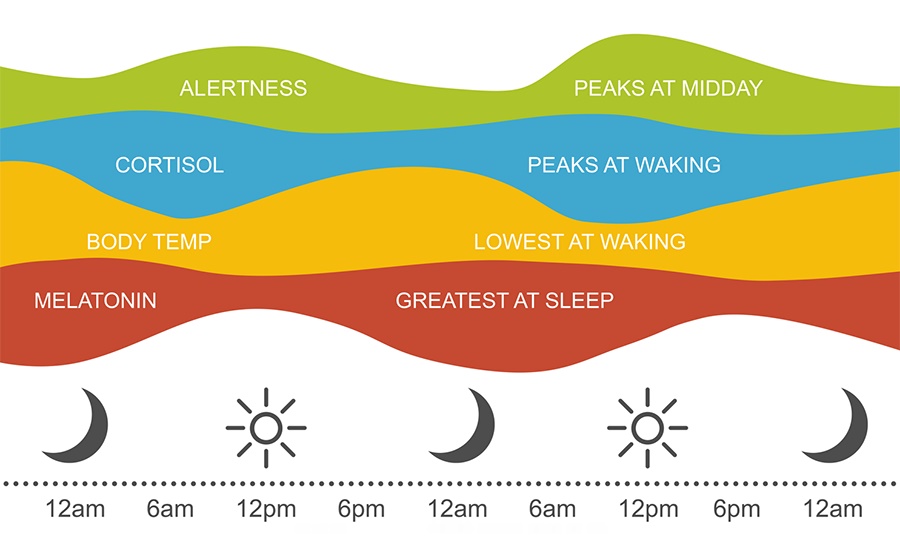Lighting Impacts on Circadian Rhythms

With the emergence of human health concerns, wellness, and biophilia as priorities in the building design and construction industry, the lighting profession is shifting its focus toward circadian lighting design.
Light is one of the main drivers of circadian rhythms—that is, our internal clock that keeps the body's hormones and bodily processes on a diurnal cycle, even in continuous darkness. When the human body receives light—any kind of light—the brain is stimulated and regulates physiological rhythms throughout the body's tissues and organs, impacting hormone levels and the sleep-wake cycle.
Circadian Rhythms
Circadian rhythms are kept on a regular cycle by various cues from the environment, including light. One of the ways in which the human body responds to light is facilitated by intrinsically photosensitive ganglion cells (ipRGCs). Essentially, ipRGCs are the are eyes' non-image-forming photoreceptors. They relay environmental light levels to the suprachiasmatic nucleus in the brain through the retinohypothalamic tract—this is the main clock that acts as an oscillator to synchronize clocks in peripheral tissues and organs. High frequency light will promote bodily alertness, while a lack of light will cue the body to reduce energy expenditures and prepare for rest.
Moreover, ipRGCs are especially sensitive to blue light. Skylight is going to prompt the brain to become more awake and alert. This is why staring at a tablet screen before sleeping might not be such a good idea for those with sleeping difficulties.
Zeitgebers
Throughout a 24-hour period, the body responds to a number of zeitgebers—the external cures that align physiological functions to the solar day. Light is one of the most important zeitgebers. Light stimulates the ipRGCs, which triggers the suprachiasmatic nucleus to prompt the pineal gland to secrete less melatonin—the "darkness hormone" whose levels acts a driver for sleep.
|
The human body's circadian rhythms follow a diurnal cycle in response to a number of zeitgebers, the most important of which is light. Illustration by Daniel Overbey. |
Circadian Lighting Design
Circadian lighting design does not necessitate that designers rush out and get a degree in human physiology. Rather, the biological effects of light on humans can be measured in equivalent melanopic lux (EML), which is a proposed alternate metric weighted to the ipRGCs instead of cones as one would do with traditional lux.
EML is promoted by the WELL Building Standard v1, which contains a feature dedicated to circadian lighting design.
Calculating EML
In accordance with the WELL Building Standard v1, the equivalent melanopic lux (EML) can be calculated by multiplying the visual lux (L) designed for or measured in a building by a melanopic ratio (R) based on the light source:
EML = L × R
WELL v1 provides the following melanopic ratios for common light sources:
|
Table: Melanopic Ratio by Light Source |
WELL v1 provides the following examples: if incandescent lights provide 200 lux in a space, they will also produce 108 equivalent melanopic lux. If daylight is modeled to provide the same visual brightness (200 lux), it will also provide 220 equivalent melanopic lux.


